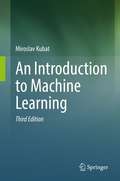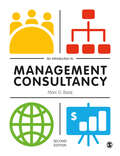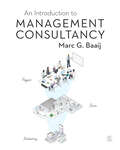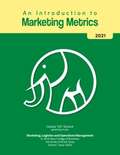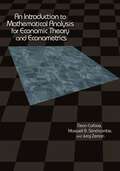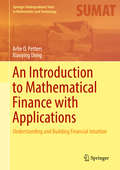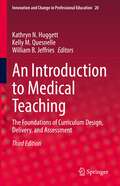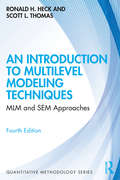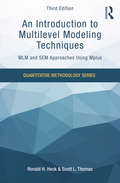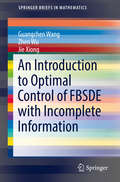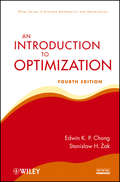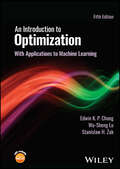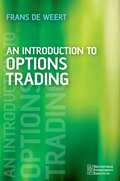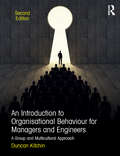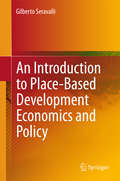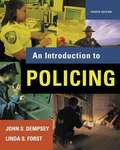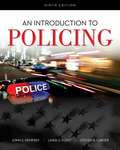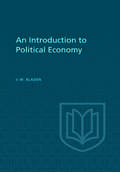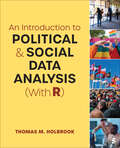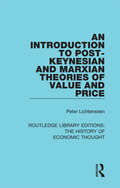- Table View
- List View
An Introduction to Machine Learning
by Miroslav KubatThis textbook offers a comprehensive introduction to Machine Learning techniques and algorithms. This Third Edition covers newer approaches that have become highly topical, including deep learning, and auto-encoding, introductory information about temporal learning and hidden Markov models, and a much more detailed treatment of reinforcement learning. The book is written in an easy-to-understand manner with many examples and pictures, and with a lot of practical advice and discussions of simple applications. The main topics include Bayesian classifiers, nearest-neighbor classifiers, linear and polynomial classifiers, decision trees, rule-induction programs, artificial neural networks, support vector machines, boosting algorithms, unsupervised learning (including Kohonen networks and auto-encoding), deep learning, reinforcement learning, temporal learning (including long short-term memory), hidden Markov models, and the genetic algorithm. Special attention is devoted to performance evaluation, statistical assessment, and to many practical issues ranging from feature selection and feature construction to bias, context, multi-label domains, and the problem of imbalanced classes.
An Introduction to Management Consultancy
by Marc G. BaaijWhether you are preparing for a management consultancy career or only want to acquire widely applicable consultancy skills, you will need a clear and concise introduction to this area. This fully updated second edition text provides you with a practical, step-by-step guide to learn the proven successful methods and techniques of the world′s leading management consultancy firms. Detailed descriptions and real-life illustrations enable you to develop consultancy skills for structured problem-solving, critical thinking, collaboration and communication. Additionally, this text provides rich insights into the latest developments in the consultancy industry and their firms. It includes alumnus of a top management consultancy firm and is essential reading for aspiring consultants as well as anyone dealing with consultants in their career.
An Introduction to Management Consultancy
by Marc G. BaaijWhether you are preparing for a management consultancy career or only want to acquire widely applicable consultancy skills, you will need a clear and concise introduction to this area. This fully updated second edition text provides you with a practical, step-by-step guide to learn the proven successful methods and techniques of the world′s leading management consultancy firms. Detailed descriptions and real-life illustrations enable you to develop consultancy skills for structured problem-solving, critical thinking, collaboration and communication. Additionally, this text provides rich insights into the latest developments in the consultancy industry and their firms. It includes alumnus of a top management consultancy firm and is essential reading for aspiring consultants as well as anyone dealing with consultants in their career.
An Introduction to Management Consultancy
by Marc G. BaaijWhether you are looking to build on your management studies or experience of working in business, you are likely to have come across management consultancy and will need a clear and concise introduction to this area to help you understand its practices and techniques in order to hire and implement management consultancy in the future. This text provides you with these essentials for success in your studies and later industries when working with and not just for consultancy firms. The text is built around learning objectives to empower your understanding of the 'what', 'how', 'when' and 'why' at macro and micro levels of management consultancy and its stakeholders, and provides you with engaging real life examples and extra web materials for study. As well as full courses on management consultancy, this text will be invaluable to your management knowledge and skill-set across strategy, change, analytics, problem-solving, solution implementation and decision-making as applied by the world's top management consulting firms, such as McKinsey & Company, The Boston Consulting Group, and Bain & Company. Visit the companion website www.sagepub.co.uk/baaij Lecturer's resources Lecturer's guide Teaching notes per chapter Answer guidance to end-of-chapter questions in book Suggested discussion questions Suggested small group assignments Suggested small group field project Lecture slides Option 1: provide all figures of the book on PowerPoint slides Option 2: create complete PowerPoint presentations for each chapter Exercises Exam questions Discussion forum Student resources Templates for developing logical structures Web resources Consultancy publications Consultancy web site, career page Job application preparation services Consultancy institutions
An Introduction to Marketing Metrics
by Gopala Gg" Ganesh“This book has resulted from a successful attempt to build the first undergraduate Marketing Metrics course in the world. To date, the course has been completed by more than 7,000 students- usually in traditional classroom settings and occasionally as an online class as well. Originally called Marketing Tools and Skills, the course was eventually renamed as Marketing and Money and then renamed again as Marketing Metrics (MM). This final name is the right one because metrics is the core topic of the course. I view MM as my magnum opus, my unique and hopefully long-lasting contribution to the marketing discipline.” – by the author.
An Introduction to Mathematical Analysis for Economic Theory and Econometrics
by Juraj Zeman Dean Corbae Maxwell StinchcombeProviding an introduction to mathematical analysis as it applies to economic theory and econometrics, this book bridges the gap that has separated the teaching of basic mathematics for economics and the increasingly advanced mathematics demanded in economics research today. Dean Corbae, Maxwell B. Stinchcombe, and Juraj Zeman equip students with the knowledge of real and functional analysis and measure theory they need to read and do research in economic and econometric theory. Unlike other mathematics textbooks for economics, An Introduction to Mathematical Analysis for Economic Theory and Econometrics takes a unified approach to understanding basic and advanced spaces through the application of the Metric Completion Theorem. This is the concept by which, for example, the real numbers complete the rational numbers and measure spaces complete fields of measurable sets. Another of the book's unique features is its concentration on the mathematical foundations of econometrics. To illustrate difficult concepts, the authors use simple examples drawn from economic theory and econometrics. Accessible and rigorous, the book is self-contained, providing proofs of theorems and assuming only an undergraduate background in calculus and linear algebra. Begins with mathematical analysis and economic examples accessible to advanced undergraduates in order to build intuition for more complex analysis used by graduate students and researchers Takes a unified approach to understanding basic and advanced spaces of numbers through application of the Metric Completion Theorem Focuses on examples from econometrics to explain topics in measure theory
An Introduction to Mathematical Finance with Applications: Understanding and Building Financial Intuition (Springer Undergraduate Texts in Mathematics and Technology)
by Arlie O. Petters Xiaoying DongThis textbook aims to fill the gap between those that offer a theoretical treatment without many applications and those that present and apply formulas without appropriately deriving them. The balance achieved will give readers a fundamental understanding of key financial ideas and tools that form the basis for building realistic models, including those that may become proprietary. Numerous carefully chosen examples and exercises reinforce the student's conceptual understanding and facility with applications. The exercises are divided into conceptual, application-based, and theoretical problems, which probe the material deeper. The book is aimed toward advanced undergraduates and first-year graduate students who are new to finance or want a more rigorous treatment of the mathematical models used within. While no background in finance is assumed, prerequisite math courses include multivariable calculus, probability, and linear algebra. The authors introduce additional mathematical tools as needed. The entire textbook is appropriate for a single year-long course on introductory mathematical finance. The self-contained design of the text allows for instructor flexibility in topics courses and those focusing on financial derivatives. Moreover, the text is useful for mathematicians, physicists, and engineers who want to learn finance via an approach that builds their financial intuition and is explicit about model building, as well as business school students who want a treatment of finance that is deeper but not overly theoretical.
An Introduction to Mathematics for Economics
by Akihito AsanoAn Introduction to Mathematics for Economics introduces quantitative methods to students of economics and finance in a succinct and accessible style. The introductory nature of this textbook means a background in economics is not essential, as it aims to help students appreciate that learning mathematics is relevant to their overall understanding of the subject. Economic and financial applications are explained in detail before students learn how mathematics can be used, enabling students to learn how to put mathematics into practice. Starting with a revision of basic mathematical principles the second half of the book introduces calculus, emphasising economic applications throughout. Appendices on matrix algebra and difference/differential equations are included for the benefit of more advanced students. Other features, including worked examples and exercises, help to underpin the readers' knowledge and learning. Akihito Asano has drawn upon his own extensive teaching experience to create an unintimidating yet rigorous textbook.
An Introduction to Medical Teaching: The Foundations of Curriculum Design, Delivery, and Assessment (Innovation and Change in Professional Education #20)
by William B. Jeffries Kathryn N. Huggett Kelly M. QuesnelleThis is an introductory text designed to provide medical teachers with a comprehensive introduction to the core concepts of effective teaching practice. It contains introductory-level information about innovations for curriculum design, delivery, and assessment, all in a singular text. The work offers brief, focused chapters with content that can be easily assimilated by the reader. The topics are relevant to basic science and clinical teachers, and the work does not presume readers possess prerequisite knowledge of education theory or instructional design.The book builds upon and extends the content of the second edition by incorporating additional content to reflect advances in cognitive science and by updating existing chapters to keep pace with modern educational trends and technologies.
An Introduction to Multilevel Modeling Techniques: MLM and SEM Approaches Using Mplus (Quantitative Methodology Series)
by Ronald H. Heck Scott L. ThomasMultilevel modelling is a data analysis method that is frequently used to investigate hierarchal data structures in educational, behavioural, health, and social sciences disciplines. Multilevel data analysis exploits data structures that cannot be adequately investigated using single-level analytic methods such as multiple regression, path analysis, and structural modelling. This text offers a comprehensive treatment of multilevel models for univariate and multivariate outcomes. It explores their similarities and differences and demonstrates why one model may be more appropriate than another, given the research objectives. New to this edition: An expanded focus on the nature of different types of multilevel data structures (e.g., cross-section, longitudinal, cross-classified, etc.) for addressing specific research goals Varied modelling methods for examining longitudinal data including random-effect and fixed-effect approaches Expanded coverage illustrating different model-building sequences and how to use results to identify possible model improvements An expanded set of applied examples used throughout the text Use of four different software packages (i.e., Mplus, R, SPSS, Stata), with selected examples of model-building input files included in the chapter appendices and a more complete set of files available online This is an ideal text for graduate courses on multilevel, longitudinal, latent variable modelling, multivariate statistics, or advanced quantitative techniques taught in psychology, business, education, health, and sociology. Recommended prerequisites are introductory univariate and multivariate statistics.
An Introduction to Multilevel Modeling Techniques: MLM and SEM Approaches Using Mplus, Third Edition (Quantitative Methodology Series )
by Ronald H. Heck Scott L. ThomasUnivariate and multivariate multilevel models are used to understand how to design studies and analyze data in this comprehensive text distinguished by its variety of applications from the educational, behavioral, and social sciences. Basic and advanced models are developed from the multilevel regression (MLM) and latent variable (SEM) traditions within one unified analytic framework for investigating hierarchical data. The authors provide examples using each modeling approach and also explore situations where alternative approaches may be more appropriate, given the research goals. Numerous examples and exercises allow readers to test their understanding of the techniques presented. Changes to the new edition include: -The use of Mplus 7.2 for running the analyses including the input and data files at www.routledge.com/9781848725522. -Expanded discussion of MLM and SEM model-building that outlines the steps taken in the process, the relevant Mplus syntax, and tips on how to evaluate the models. -Expanded pedagogical program now with chapter objectives, boldfaced key terms, a glossary, and more tables and graphs to help students better understand key concepts and techniques. -Numerous, varied examples developed throughout which make this book appropriate for use in education, psychology, business, sociology, and the health sciences. -Expanded coverage of missing data problems in MLM using ML estimation and multiple imputation to provide currently-accepted solutions (Ch. 10). -New chapter on three-level univariate and multilevel multivariate MLM models provides greater options for investigating more complex theoretical relationships(Ch.4). -New chapter on MLM and SEM models with categorical outcomes facilitates the specification of multilevel models with observed and latent outcomes (Ch.8). -New chapter on multilevel and longitudinal mixture models provides readers with options for identifying emergent groups in hierarchical data (Ch.9). -New chapter on the utilization of sample weights, power analysis, and missing data provides guidance on technical issues of increasing concern for research publication (Ch.10). Ideal as a text for graduate courses on multilevel, longitudinal, latent variable modeling, multivariate statistics, or advanced quantitative techniques taught in psychology, business, education, health, and sociology, this book’s practical approach also appeals to researchers. Recommended prerequisites are introductory univariate and multivariate statistics.
An Introduction to Nursing Informatics, Evolution, and Innovation, 2nd Edition: Evolution and Innovation (HIMSS Book Series)
by Susan M. Houston Tina Dieckhaus Bob Kircher Michelle LardnerNursing informatics (NI) is the specialty that integrates nursing science with information management and analytical sciences to identify, define, manage, and communicate data, information, knowledge, and wisdom in nursing practice. Nursing Informatics supports nurses, consumers, patients, the interprofessional healthcare team, and other stakeholders in a wide variety of roles and settings to achieve desired outcomes. This is accomplished through the use of information structures, information processes, and information technology. An Introduction to Nursing Informatics, Evolution and Innovation, 2nd Edition is the ideal gateway to all the professional possibilities this continuously evolving discipline has to offer. Describing the evolution of nursing informatics from its origins to current practice in today’s complex, diverse healthcare environment, this book offers the next generation of nurse informaticists an understanding of the discipline, best practices, and its scope of influence in healthcare. The book also explores Nursing Informatics as it is evolving into the future, including technology creation and implementation and the development of influential policies and best practices. Special features include descriptions of the ‘a day in the life’ from informatics nurses in multiple roles and fields of influence, including academia, research, clinical settings, the executive suite, consulting, and government, as well as an Appendix featuring case profiles. This new edition updates the content to better align with the current state of nursing informatics and expand on additional roles. New to this edition is a chapter providing tips and advice for those trying to find their first nursing informatics job or are changing their careers. Another new chapter covers healthcare analytics and how it fits into the nursing informatics role. An Introduction to Nursing Informatics, Evolution and Innovation, 2nd Edition is the ideal resource for nursing students and as a reference guide and pint of inspiration for nurses currently in the field.
An Introduction to Operations Management: The Joy of Operations
by Ajay DasAn Introduction to Operations Management: The Joy of Operations covers the core topics of operations management, including product and service design, processes, capacity planning, forecasting, inventory, quality, supply chain management, and project management. Das provides a clear, connected, and current view of operations management and how it relates to a firm’s strategic goals. Students will benefit from the real-world scenarios that foster an understanding of operations management tasks. Without relying heavily on statistics and mathematical derivations, the book offers applied models and a simple, predictable chapter format to make it easy to navigate. Students of introductory operations management courses will love this practical textbook. A companion website features an instructor’s manual with test questions, as well as additional exercises and examples for in-class use.
An Introduction to Optimal Control of FBSDE with Incomplete Information (SpringerBriefs in Mathematics)
by Guangchen Wang Zhen Wu Jie XiongThis book focuses on maximum principle and verification theorem for incomplete information forward-backward stochastic differential equations (FBSDEs) and their applications in linear-quadratic optimal controls and mathematical finance. Lots of interesting phenomena arising from the area of mathematical finance can be described by FBSDEs. Optimal control problems of FBSDEs are theoretically important and practically relevant. A standard assumption in the literature is that the stochastic noises in the model are completely observed. However, this is rarely the case in real world situations. The optimal control problems under complete information are studied extensively. Nevertheless, very little is known about these problems when the information is not complete. The aim of this book is to fill this gap. This book is written in a style suitable for graduate students and researchers in mathematics and engineering with basic knowledge of stochastic process, optimal control and mathematical finance.
An Introduction to Optimization
by Edwin K. Chong Stanislaw H. ZakPraise from the Second Edition"...an excellent introduction to optimization theory..." (Journal of Mathematical Psychology, 2002)"A textbook for a one-semester course on optimization theory and methods at the senior undergraduate or beginning graduate level." (SciTech Book News, Vol. 26, No. 2, June 2002)Explore the latest applications of optimization theory and methodsOptimization is central to any problem involving decision making in many disciplines, such as engineering, mathematics, statistics, economics, and computer science. Now, more than ever, it is increasingly vital to have a firm grasp of the topic due to the rapid progress in computer technology, including the development and availability of user-friendly software, high-speed and parallel processors, and networks. Fully updated to reflect modern developments in the field, An Introduction to Optimization, Third Edition fills the need for an accessible, yet rigorous, introduction to optimization theory and methods.The book begins with a review of basic definitions and notations and also provides the related fundamental background of linear algebra, geometry, and calculus. With this foundation, the authors explore the essential topics of unconstrained optimization problems, linear programming problems, and nonlinear constrained optimization. An optimization perspective on global search methods is featured and includes discussions on genetic algorithms, particle swarm optimization, and the simulated annealing algorithm. In addition, the book includes an elementary introduction to artificial neural networks, convex optimization, and multi-objective optimization, all of which are of tremendous interest to students, researchers, and practitioners.Additional features of the Third Edition include:New discussions of semidefinite programming and Lagrangian algorithmsA new chapter on global search methodsA new chapter on multipleobjective optimizationNew and modified examples and exercises in each chapter as well as an updated bibliography containing new referencesAn updated Instructor's Manual with fully worked-out solutions to the exercisesNumerous diagrams and figures found throughout the text complement the written presentation of key concepts, and each chapter is followed by MATLAB exercises and drill problems that reinforce the discussed theory and algorithms. With innovative coverage and a straightforward approach, An Introduction to Optimization, Third Edition is an excellent book for courses in optimization theory and methods at the upper-undergraduate and graduate levels. It also serves as a useful, self-contained reference for researchers and professionals in a wide array of fields.
An Introduction to Optimization: With Applications to Machine Learning (Wiley Series In Discrete Mathematics And Optimization Ser. #77)
by Edwin K. Chong Wu-Sheng Lu Stanislaw H. ŻakAn Introduction to Optimization Accessible introductory textbook on optimization theory and methods, with an emphasis on engineering design, featuring MATLAB® exercises and worked examples Fully updated to reflect modern developments in the field, the Fifth Edition of An Introduction to Optimization fills the need for an accessible, yet rigorous, introduction to optimization theory and methods, featuring innovative coverage and a straightforward approach. The book begins with a review of basic definitions and notations while also providing the related fundamental background of linear algebra, geometry, and calculus. With this foundation, the authors explore the essential topics of unconstrained optimization problems, linear programming problems, and nonlinear constrained optimization. In addition, the book includes an introduction to artificial neural networks, convex optimization, multi-objective optimization, and applications of optimization in machine learning. Numerous diagrams and figures found throughout the book complement the written presentation of key concepts, and each chapter is followed by MATLAB® exercises and practice problems that reinforce the discussed theory and algorithms. The Fifth Edition features a new chapter on Lagrangian (nonlinear) duality, expanded coverage on matrix games, projected gradient algorithms, machine learning, and numerous new exercises at the end of each chapter. An Introduction to Optimization includes information on: The mathematical definitions, notations, and relations from linear algebra, geometry, and calculus used in optimization Optimization algorithms, covering one-dimensional search, randomized search, and gradient, Newton, conjugate direction, and quasi-Newton methods Linear programming methods, covering the simplex algorithm, interior point methods, and duality Nonlinear constrained optimization, covering theory and algorithms, convex optimization, and Lagrangian duality Applications of optimization in machine learning, including neural network training, classification, stochastic gradient descent, linear regression, logistic regression, support vector machines, and clustering. An Introduction to Optimization is an ideal textbook for a one- or two-semester senior undergraduate or beginning graduate course in optimization theory and methods. The text is also of value for researchers and professionals in mathematics, operations research, electrical engineering, economics, statistics, and business.
An Introduction to Options Trading
by Frans De WeertExplaining the theory and practice of options from scratch, this book focuses on the practical side of options trading, and deals with hedging of options and how options traders earn money by doing so. Common terms in option theory are explained and readers are shown how they relate to profit. The book gives the necessary tools to deal with options in practice and it includes mathematical formulae to lift explanations from a superficial level. Throughout the book real-life examples will illustrate why investors use option structures to satisfy their needs.
An Introduction to Organisational Behaviour for Managers and Engineers: A Group and Multicultural Approach
by Duncan KitchinAn Introduction to Organisational Behaviour for Managers and Engineers: A Group and Multicultural Approach gives a comprehensive overview of how organisations work, with a special focus on group and team working, and issues of diversity and intercultural management. This second edition has been updated throughout, drawing on the latest literature, along with: a new chapter on organisational change, a process which all managers and engineers will encounter on the job; case studies and illustrations showing theories in action; more cross-referencing between chapters, showing how topics are interlinked. This concise textbook not only provides a practical introduction to organisational behaviour for management students, but is also specifically geared towards the needs of engineering students and professionals.
An Introduction to Place-Based Development Economics and Policy
by Gilberto SeravalliThis book introduces the reader to local development economics and policy, with a special focus on the place-based paradigm that covers its justification, its difficulties and the types of public intervention that it suggests. The starting point for the analysis is that economic development in lagging places is not to be expected as the result of a mechanism of automatic convergence between backward and advanced regions and that, therefore, the most appropriate development policy is not to maximize competition among all agents in all sectors and places. The failure of the Washington Consensus is examined, and the two competing positions to have emerged from this failure - spatially blind interventions and place-based policies - are contrasted. The main shortcoming of spatially blind policies, namely that immobile resources that could trigger or support a development process often remain untapped or "trapped", is emphasized. The limitations of the "big push" state intervention and wage flexibility solutions to this trap are analyzed and the merits of place-based policies that support intervention and can deal with uncertainty, risk and conflict are discussed.
An Introduction to Policing
by John S. Dempsey Linda S. ForstAimed at students considering a career in law enforcement, this textbook offers an insider's look at the policing profession. Topics discussed include (for example) the organization of police departments, the representation of minorities in today's police forces, the role of computers in policing, and the debate surrounding community policing. Most chapters in the fourth edition feature a "Guest Lecture" by a practitioner addressing a key issue in law enforcement. Annotation ©2007 Book News, Inc. , Portland, OR (booknews. com)
An Introduction to Policing (Mindtap Course List Series)
by John Dempsey Steven Carter Linda ForstDiscover the challenges, excitement and rewards of law enforcement today with Dempsey, Forst, and Carter's AN INTRODUCTION TO POLICING, 9th Edition. Written by law enforcement veterans with extensive first-hand experience in all areas of policing, this book is an essential read for you or anyone you know who is considering a career in law enforcement. You'll get insight into the Black Lives Matter movement, questionable police shootings of civilians and ambush shootings of police officers, strained police-community relations, the President's Task Force on 21st Century Policing, recent terrorism incidents, Specialized Policing Responses to homeless individuals, advances in policing technology and other current issues. You'll also find the latest research as well as up-to-date applications, statistics, court cases and information on law enforcement careers.
An Introduction to Political Economy
by Vincent BladenNewly revised by the author (1956), this text-book for beginning students is also designed for general readers who want to know what economics is and how economists think. It analyses the size and composition of the wage-earner in modern industry, Canadian public policy in relation to combines, and the the social problems of the special problems of the Canadian wheat-growing and newsprint industries. "...an interesting, instructive, and valuable book full of essential information."
An Introduction to Political and Social Data Analysis (With R)
by Thomas M. HolbrookAn Introduction to Political and Social Data Analysis (With R) provides students with an accessible overview of practical data analysis while also providing a gentle introduction to R. By starting with statistics first and using just enough R code to generate results, this text helps students focus on learning how to do data analysis while slowly gaining confidence in using R as they progress through the material. This book is structured around learning by doing. Students can follow along in each chapter by reading about statistics and their applications in R, and then running the R code on their own as they work through contemporary political science and social science examples. Author Thomas M. Holbrook patiently explains each step in in the process, avoiding overly complicated jargon and commands. Exercises at the end of chapters feature both conceptual and calculation-based questions so students can check their understanding of data analysis and practice using R. At the end of the semester, students can confidently add skills in data analysis with R to their resumes.
An Introduction to Political and Social Data Analysis (With R)
by Thomas M. HolbrookAn Introduction to Political and Social Data Analysis (With R) provides students with an accessible overview of practical data analysis while also providing a gentle introduction to R. By starting with statistics first and using just enough R code to generate results, this text helps students focus on learning how to do data analysis while slowly gaining confidence in using R as they progress through the material. This book is structured around learning by doing. Students can follow along in each chapter by reading about statistics and their applications in R, and then running the R code on their own as they work through contemporary political science and social science examples. Author Thomas M. Holbrook patiently explains each step in in the process, avoiding overly complicated jargon and commands. Exercises at the end of chapters feature both conceptual and calculation-based questions so students can check their understanding of data analysis and practice using R. At the end of the semester, students can confidently add skills in data analysis with R to their resumes.
An Introduction to Post-Keynesian and Marxian Theories of Value and Price (Routledge Library Editions: The History of Economic Thought)
by Peter M. LichtensteinPeter M. Lichtenstein believes that any social-economic theory of capitalism must begin with a theory of value and price. Dismissing the neoclassical school, he turns to post-Keynesian and Marxian economics with their coherent and consistent theories of value and price based on concrete objective circumstances. The development of these theories in the author’s aim because he believes that this approach comes much closer than neoclassical theory to capturing the essence of a capitalism economy. This book, first published in 1983, is addressed to economics students, especially to those studying microeconomics or the history of economic thought, and to economists seeking an overview of these issues.
